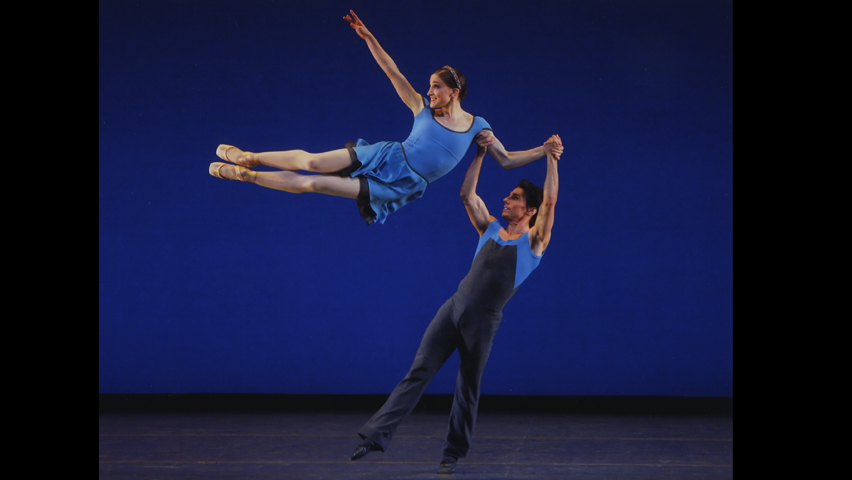10 May 2020. Digital Spring Season
Alexei Ratmansky’s Concerto DSCH premiered in 2008 and was the second ballet Ratmansky made for New York City Ballet. In the introduction to this digital stream (which is of a production filmed in 2018), Ratmansky talks briefly about the music, Dmitri Shostakovich’s Piano Concerto No 2 in F; the origins of that music; the double reference arising from the use of DSCH in the title of the work;* and a little about working with the dancers. All that he says is interesting, but nothing compares with the movement itself.
Concerto DSCH follows the three movements of the concerto and is danced by five soloists and a corps de ballet of fourteen dancers. The soloists comprise a trio of a woman and two men (Ashley Bouder, Joaquin De Luz and Gonzalo Garcia), and a duo of a woman and a man (Sara Mearns and Tyler Angle). The trio dominates the first movement. De Luz and Garcia show us expansive jumps and stretched legs, and virtuosic turns both on the ground and in the air. Bouder also stands out for her fast and perfect turning steps, and for a personality that shines throughout. As a group the three have a definite relationship but it is not exactly clear what that relationship is, other than it is a changing one. The corps de ballet often seems to be commenting on the actions of the trio but their dancing also demonstrates Ratmansky’s constant and always fascinating use of the stage space to arrange and rearrange groups of dancers.
The second movement is for the most part a pas de deux. Although Mearns and Angle appear in the first movement, the second is theirs even though the corps de ballet is also involved to a certain extent. Sometimes the corps mirrors what is happening in the pas de deux, at one stage they enclose Mearns and Angle in a circle, and sometimes they simply sit and watch what is happening.
The pas de deux vocabulary is liquid and filled with draped poses and sliding movements, with of course some thrilling lifts. Again there is a relationship, a definite emotional connection, between the two dancers, and at the end of the movement they part, each leaving via a different side of the stage, and each with a backward glance towards the other. Do we attribute this to a breakdown in a relationship? They often reach out to each other during the pas de deux, but scarcely touch on those occasions. But then in his introductory remarks to the streaming Ratmansky says he tells the dancers he is working with in this section to imagine they are young students out walking in a Russian city during the Winter Nights. So it is not really clear just what the connection between the two actually is.
The third movement speeds along in the manner of the first with an opening in which the five soloists engage with each other before the corps comes back in various combinations. The whole becomes like a choreographic coda.
Concerto DSCH is an astonishing work. It has virtuosity in spades, a sprinkle of humour, and those interpersonal connections—this latter a little surprising, and certainly cause for speculation. On the one hand the work is largely an abstract one, yet there is that definite emotional connection between the dancers. It might not be specific but it is there and indicates Ratmansky’s apparent interest in layering meaning and abstraction.
Ratmansky’s choreography never ceases to amaze, thrill and regularly surprise. I wondered, however, about the impact on his choreography of his interest, which I just recently read about, in Petipa and the Stepanov notation of Petipa’s works. In a review of Nadine Meisner’s relatively recent book on Petipa (Marius Petipa: The Emperor’s Ballet Master), the reviewer (Simon Morrison) writes:
The resident choreographer of American Ballet Theatre, Alexei Ratmansky, has studied the Stepanov notation of Petipa’s ballets. ‘You can’t remove a step without destroying the whole structure,’ he has said. But ‘so much small footwork’ has been lost; the hop between fouetté and the arabesque in Paquita for example. **
Ratamnsky’s choreography is filled with small ‘between’ steps and, while it is his own remarkable work, I can’t help wondering about his use of what he has noticed has been lost over the years from Petipa’s choreography. But then those ‘between’ steps also indicate the musicality that imbues Ratmansky’s work. Let’s hope we see more of his choreography in Australia in due course.
Michelle Potter, 11 May 2020
*DSCH forms and abbreviation of Shostakovitch’s name when written in German. It also refers to a musical motif.
* *Simon Morrison, ‘The bedroom of a sorcerer.’ London Review of Books, 2 April 2020. Review of Nadine Meisner, Marius Petipa: The Emperor’s Ballet Master (Oxford, July 2019).
Featured image: Ashley Bouder and Joaquin De Luz in the opening movement of Concerto DSCH. New York City Ballet. Photo: © Paul Kolnik, from the New York City Ballet official website.
